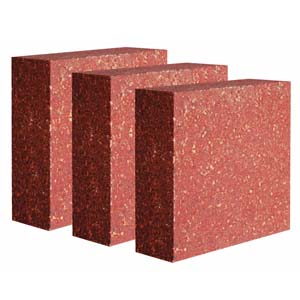Six performance magnesia carbon brick prices of refractory materials
The performance of refractory materials refers to the performance of refractory materials when used at high temperatures. Including refractoriness, load softening temperature, reburning linear change rate, thermal shock resistance, slag resistance, vacuum resistance, etc.
(1) Refractoriness
Refractoriness refers to the property of refractory materials that resist high temperature without melting when there is no load. It is used to characterize the performance of refractory materials against high temperature effects. Refractoriness is the basis for judging whether a material can be used as a refractory material. The International Organization for Standardization stipulates that inorganic non-metallic materials with a refractoriness above 1500°C are refractory materials. The meaning of refractoriness is different from the melting point, and refractoriness cannot be used as the use temperature of refractory materials.
(2) Load softening temperature
The load softening temperature is the temperature at which the refractory material reaches a certain compression deformation under the combined action of a certain heavy load and thermal load. It is an important index of the high temperature mechanical properties of the refractory material. It characterizes the refractory material’s resistance to heavy load and high temperature heat. The ability to maintain stability under the combined action of load. The high temperature load deformation temperature of refractories is an important quality index, because it indicates to a certain extent the structural strength of the product under conditions similar to its use. The main factor that determines the softening temperature under load is the chemical mineral composition of the product, which is also directly related to the production process of the product.
(3) Linear change rate of reburning (high temperature volume stability)
The high-temperature volume stability of refractory materials refers to the performance of the product's appearance volume or linearity remain stable without permanent deformation when used for a long time at high temperatures. For sintered products, it is generally measured by the volume change rate of refired or linear change rate of refired under no heavy load. The reburning volume change is also called residual volume deformation, and the reburning line change is also called residual line deformation. The re-firing deformation of refractory products is of great significance for judging the high-temperature volume stability of the products, ensuring the stability of the masonry, reducing the gaps of the masonry, improving its sealing and corrosion resistance, and avoiding the destruction of the overall structure of the masonry. .
(4) Thermal shock resistance
Thermal shock resistance is also called rapid cold and rapid heat resistance, which characterizes the ability of refractory products to resist sharp changes in temperature without being damaged.
In actual work, refractory materials often suffer from rapid temperature changes. The working temperature changes greatly in a short period of time. This rapid temperature change is called thermal shock. Thermal shock can cause cracking, peeling and collapse of refractory materials. Therefore, when the working temperature of the refractory material changes sharply in use, its thermal shock resistance must be examined.
To improve the thermal shock resistance of the material and avoid cracks in the material, the strength of the material must be improved, especially the tensile strength and shear strength, to improve the ability to resist crack formation, and the elastic modulus and Poisson's ratio of the material should be reduced. , Thereby reducing the possible thermal stress.

(5) Resistance to slag
Slag resistance refers to the ability of refractory materials to resist the erosion and erosion of slag at high temperatures. The concept of slag here broadly refers to metallurgical slag, fuel ash, fly ash, various materials and gaseous substances at the junction with refractory materials at high temperatures.
(6) Vacuum resistance
In general, the vapor pressure of refractory materials at room temperature is very low, which can be considered to be extremely stable and non-volatile. However, when working under high temperature and reduced pressure, its volatility will become a non-negligible problem, which will cause loss due to its volatilization reduction and accelerate its damage. Under such conditions, unlike the use under high temperature, normal temperature and atmospheric pressure, vacuum resistance has become one of the important characteristics of refractory materials.









